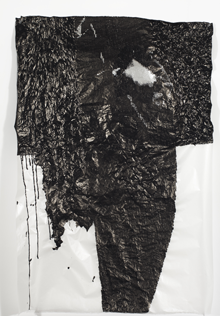 'NIGHT FLIGHT' Sumi ink and acrylic on gampi paper;
37.5 inches by 25.75 inches by 3 inches; 2014. |
At what point does process become image? What is lost, or gained, in translation from one medium to another, from one dimension to another? When does the space between things become more important than the things themselves?
Andrea Sulzer’s “throughoutsideways” at the Portland Museum of Art contains only three older pieces (older meaning from two years ago). All others were finished this year — within the past four months to be exact. That freshness comes across as a flow of multiple strands of exploration, beginnings of new directions, and exuberant intellectual curiosity transporting us into a continuous state of wonder.
One recurring theme is interstice as concept and practice, be it in the form of air, the relationship between different media, or the space that separates abstraction and figuration. With its mass of calligraphic ink marks, “cloud sound” (do they make sound?) evokes earlier drawings, but instead of representational fragments, here space and our perception of it are activated with some areas seemingly advancing, others receding. The result is a vertigo-inducing uncertainty in between.
Good art like Sulzer’s asks more questions than it answers. For example: what is representation other than superstition? In 1797, Francisco de Goya painted “The Witches’ Flight” in which three airborne witches carry off a writhing male into the black void surrounding them, whilst two peasants try to block their senses to shut out this vision, and a donkey, symbol of ignorance, looks on. The painting has served as a springboard for Sulzer’s imagination. In the most directly related work, she sculpted the three witches out of modeling clay, envisioning a two-dimensional representation in the round, and then literally filled the air between and around them with black clay (imagine for a moment the witches being gradually enveloped by suffocating blackness). Instead of shaping a block of material into form, the latter is hidden within only to be unrecognizably revealed again when the artist cuts the mass into slices like MRI scans of the anatomy of human fears and beliefs — or inspirations.
Goya’s satire of belief in witchcraft and superstition can serve as a metaphoric critique of representation itself in its convincing visualization of an imaginary occurrence. To state the obvious, representation is an illusion as well as “a trust in magic” and “false conception of causation,” — partial definitions of superstition. The penitential corozas Goya’s witches wear have an intriguing formal similarity and suggestive conceptual relation to Christian mitres and dunce caps, mixing superstition with religion and ignorance. The conical shapes that have repeatedly surfaced in Sulzer’s work thus resonate with multivalent suggestions connected to knowledge and morality.
Is representation about what defines an image or what obliterates it? Several works embody an ostensible struggle with the urge to represent, “night flight” and “night mound” among them. Repeated applications of sumi ink to gampi paper caused it to buckle and pucker into mounds and crevices. Bursting forth from that darkness are latticeworks of light ovals accentuated with iridescent acrylic, which suggest mechanical reproduction of an unrecognizable image. We are left with a nightmarish inkling of unsavory, nocturnal things flying (like witches). “Stephen” suggests a Polaroid portrait created from modeling clay, but the way Sulzer both builds up and gouges out the features is truly subversive.